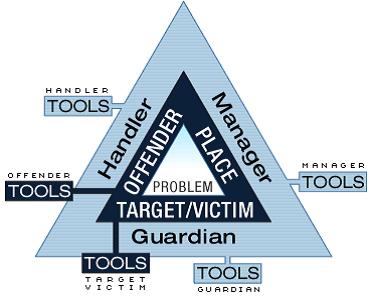Understanding the Redwine Model (TRM-COVOR)—THEORETICAL ASSUMPTIONS
Routine Activities Theory (RAT) underlies all prevention analysis provided by TRM-COVOR systems. “The theory states that a crime occurs when the following three elements come together in any given space and time: 1) An accessible target, 2) The absence of capable guardians that could intervene, and 3) the presence of a motivated offender,” (New South Wales Attorney General Office 2011).
This theory is one of the main theories of environmental criminology, providing, “simple and powerful insight into the causes of crime problems,” (Center for Problem Oriented Policing 2013). It has been suggested that if one of the three elements is eliminated a crime is prevented.
RAT can also assist in the initial determination of a missing child by uncovering whether the possibility of criminal action existed in the first place. It has been determined that in the case of Dylan Redwine, multiple opportunities presented themselves.
RAT also makes it clear that, “the spatial ordering of crime opportunities and the routines of offenders and victims creates many of the crime problems we see,” (Center for Problem Oriented Policing 2013). It focuses on settings instead of offenders, and seeks to, “forestall the occurrence of crime,” (Clarke 1997).
The bottom-line is situational prevention will bring lower levels of crime.
Suggested Reading
Center for Problem Oriented Policing. A Theory of Crime Problems. 2013. Center for Problem Oriented Policing. 2-19-2013.
Clarke, Ronald V. Situational Crime Prevention. [2nd]. 1997. Guilderland, New York, Harrow and Heston. 3-3-2013.
New South Wales Attorney General’s Office. Routine Activity Theory. 2011. State of New South Wales through the Department of Attorney General and Justice. 4-5-2013.
Posted on May 8, 2013, in COVOR Facts, Craig Byrnes, Dylan in the News, Geographic Intelligence Systems, Prevention Tips, Understanding the Redwine Model and tagged analysis, Child Abduction, child saftey, Colorado, COVOR FACT, crime prevention, criminal intelligence analysis, Dylan Redwine, GIS, information, knowledge, La Plata County, Missing, Parcel Layers, Predictive Policing, Prevention, Routine activities theory, Search, statistics, The Redwine Model, tips. Bookmark the permalink. Leave a comment.


Leave a comment
Comments 0